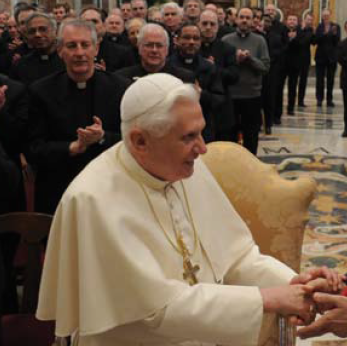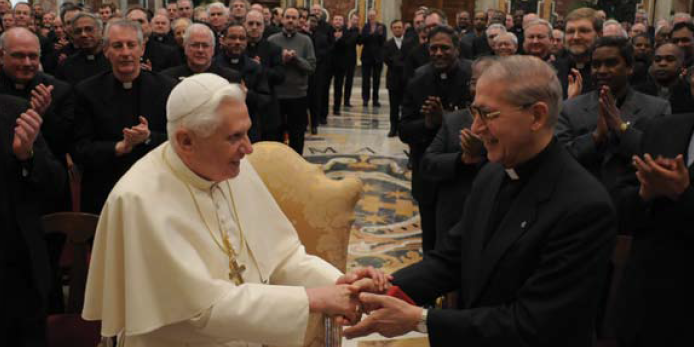
The Point and Usefulness of a Jesuit General Congregation
The Society of Jesus is sometimes described as “a monarchy.” It has very few democratic moments , though it is full of broad consultation of its members. But its founder, Ignatius of Loyola, was a soldier, not a debater. He did not want his followers—the men later called Jesuits —to wast e a lot of time in endless discuss ion: there was too much work they had to do!
So it may seem ironic, to people involved in Jesuit institutions, that not only do meetings of various kinds consume so much of their time and energy, but that the Jesuits seem to regard as so important these big, lengthy meetings they call “General Congregations.” True, they don’t happen very often (since 1541 there have been only thirty-five), but when they do, GCs seem to loom very large in Jesuit life, and are the subject of much discussion in Jesuit institutions. Why? What’s the big deal about a Jesuit General Congregation? And why should a Jesuit university, for instance, be interested in what results from it?
Well, first of all, GCs are the way the Society of Jesus insures its own future, and the future of institutions under the Jesuit aegis. The most important task this kind of meeting of representatives from all over the Jesuit world must accomplish is to elect the man who will be its leader—its “General”—for the rest of his active life. (Like the Pope, but unlike the heads of other religious orders, the Jesuit General is in “for life.”) So electing the right man is crucial. No wonder it is done in a way far different from what the word “election” brings to mind for citizens of a modern democracy. There is no “electioneering” in this election: no parties, no candidates, no platforms, no slogans—no politics! Instead, four days of prayer and silence, punctuated by one-on-one conversations between the meeting’s participants (some 220 of the world’s almost 20,000 Jesuits) which focus on two respectful questions about a third party: “Are you convinced that _____________ would be a good general? For what reasons?”
At their best, those days are a microcosm of the kind of consultation that the Jesuit “monarchical” structure must employ if it is to work: deeply reliant on honest self-disclosure and communication, presuming self-knowledge, interior freedom, good listening and mutual trust, and confident of God’s guiding hand in everything.
At the end of those four days of prayerful, discerning communication, and judgment, after an hour’s silence together in the large hall of the meeting, written ballots are conducted in silence and tallied until one man receives a majority of the votes and is declared the new Superior General of the Society of Jesus. I have never spoken to a participant in one of these elections who did not acknowledge the palpable force of the Spirit at work in the process: more than palpable enough to justify the time and effort invested in such a meeting.

But the election is not the only result of a Congregation. While it is in session, the GC is the highest authority in the Jesuit Order, functioning similarly to a university’s board of trustees. Within the framework of the Society’s Constitutions, it lays out directions, sets policy, develops guidelines for action, and determines priorities. The documents it drafts, and the issues debated in the six to eight weeks of steady, cross-cultural discussion and decision describe the way contemporary Jesuits are to carry out the evangelical work that is at the heart of our lives. In recent times these documents carry titles like: “Our Mission Today: the Service of Faith and the Promotion of Justice” or “The Union of Minds and Hearts” (GC32, 1975), “Companions of Jesus Sent Into Today’s World” (GC33, 1983), “Our Mission and Culture,” “Jesuits and University Life,” and “Cooperation with the Laity in Mission” (GC34, 1995). The most recent GC, held earlier this year, gave us the three documents that this volume will focus on: “A Fire that Kindles Other Fires: Rediscovering Our Charism,” “Challenges to Our Mission Today: Sent to the Frontiers,” and “Collaboration at the Heart of Mission.”
So a General Congregation is supposed to select the leader and set the direction for the next generation of Jesuits who will be key figures in Jesuit works—key figures, for example, in the sector of Jesuit higher education which operates more than 165 institutions worldwide.
Today, as these institutions become larger and more complex, we are well aware that Jesuits are far from being the only key figures in their lives. Jesuits are, in fact, a very small minority of the players on the educational teams responsible for “Jesuit education.” That is why what comes out of a Jesuit General Congregation is being explained and examined more than ever before across a broad spectrum of faculty, administration, and staff in our institutions. Hence, this issue of explore.